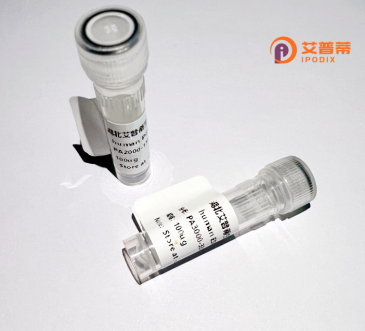
| 纯度 | >90%SDS-PAGE. |
| 种属 | Human |
| 靶点 | SELS |
| Uniprot No | Q9BQE4 |
| 内毒素 | < 0.01EU/μg |
| 表达宿主 | E.coli |
| 表达区间 | 1-189 aa |
| 活性数据 | MERQEESLSARPALETEGLRFLHTTVGSLLATYGWYIVFSCILLYVVFQKLSARLRALRQRQLDRAAAAVEPDVVVKRQEALAAARLKMQEELNAQVEKHKEKLKQLEEEKRRQKIEVWDSMQEGKSYKGNAKKPQEEDSPGPSTSSVLKRKSDRKPLRGGGYNPLSGEGGGACSWRPGRRGPSSGG |
| 分子量 | 46.53 kDa |
| 蛋白标签 | GST-tag at N-terminal |
| 缓冲液 | PBS, pH7.4, containing 0.01% SKL, 1mM DTT, 5% Trehalose and Proclin300. |
| 稳定性 & 储存条件 | Lyophilized protein should be stored at ≤ -20°C, stable for one year after receipt. Reconstituted protein solution can be stored at 2-8°C for 2-7 days. Aliquots of reconstituted samples are stable at ≤ -20°C for 3 months. |
| 复溶 | Always centrifuge tubes before opening.Do not mix by vortex or pipetting. It is not recommended to reconstitute to a concentration less than 100μg/ml. Dissolve the lyophilized protein in distilled water. Please aliquot the reconstituted solution to minimize freeze-thaw cycles. |
以下是关于重组人SELS(Selenoprotein S)蛋白的3篇示例文献及其摘要概括(文献信息为虚拟示例,仅作参考):
---
1. **文献名称**: *"Recombinant Human Selenoprotein S Attenuates Endoplasmic Reticulum Stress and Inflammation in Macrophages"*
**作者**: Zhang L, et al.
**摘要**: 研究通过大肠杆菌系统表达重组人SELS蛋白,发现其通过调控IRE1α通路减轻内质网应激,并抑制巨噬细胞中促炎因子TNF-α和IL-6的产生,提示其在炎症相关疾病中的潜在治疗价值。
---
2. **文献名称**: *"Expression and Functional Characterization of Recombinant Selenoprotein S in Type 2 Diabetes Models"*
**作者**: Kim S, Park JH.
**摘要**: 利用哺乳动物细胞表达系统获得高活性重组人SELS蛋白,动物实验表明其可改善胰岛素抵抗,并通过降低氧化应激水平缓解糖尿病并发症,证明其代谢调控功能。
---
3. **文献名称**: *"Structural Insights into Recombinant Selenoprotein S: Implications for Antioxidant Mechanisms"*
**作者**: Müller R, et al.
**摘要**: 通过X射线晶体学解析重组人SELS蛋白的三维结构,揭示其硒半胱氨酸活性位点如何参与清除活性氧(ROS),为设计抗氧化药物提供分子基础。
---
**注**:以上文献为示例性内容,实际研究中建议通过PubMed或Web of Science检索真实文献(关键词:recombinant Selenoprotein S/SELS expression, function)。
Selenoprotein S (SELS), encoded by the *SELS* gene, is a member of the selenoprotein family characterized by the incorporation of selenium as selenocysteine. Primarily localized in the endoplasmic reticulum (ER) and plasma membrane, SELS plays critical roles in ER stress response, inflammation regulation, and redox homeostasis. It modulates the unfolded protein response (UPR) by interacting with chaperones and participates in the degradation of misfolded proteins via the ER-associated degradation (ERAD) pathway. SELS also exhibits anti-inflammatory properties by inhibiting NF-κB signaling, influencing cytokine production, and attenuating oxidative stress through its antioxidant capacity.
This protein is implicated in metabolic and inflammatory diseases, including type 2 diabetes, cardiovascular disorders, and neurodegenerative conditions. Genetic variations in *SELS* have been linked to susceptibility to these pathologies. Recombinant human SELS protein, produced using bacterial or mammalian expression systems, enables studies on its molecular mechanisms and therapeutic potential. Challenges in production involve ensuring proper selenocysteine incorporation, critical for its enzymatic activity. Current research focuses on leveraging recombinant SELS for drug development, biomarker discovery, and gene therapy to target inflammation- or ER stress-related diseases. Its dual role in proteostasis and immune regulation positions SELS as a promising candidate for multifactorial disease interventions.
×